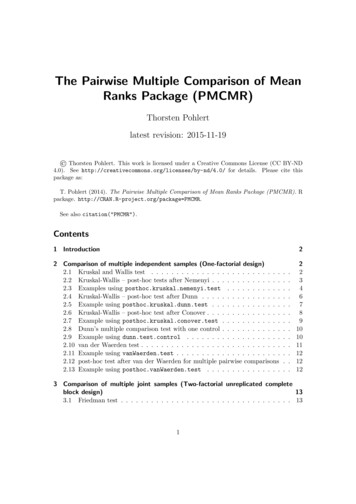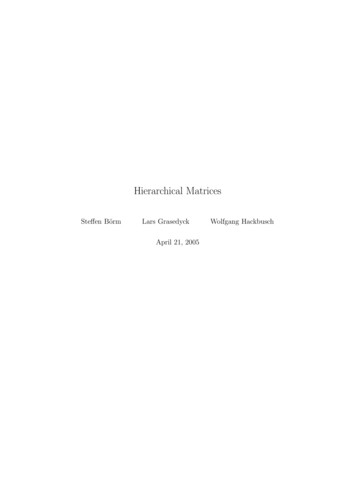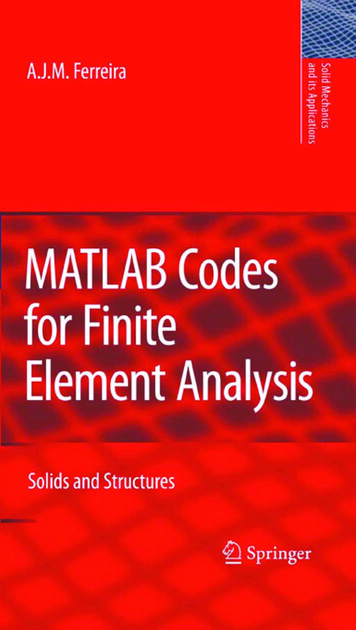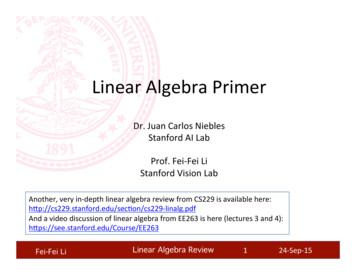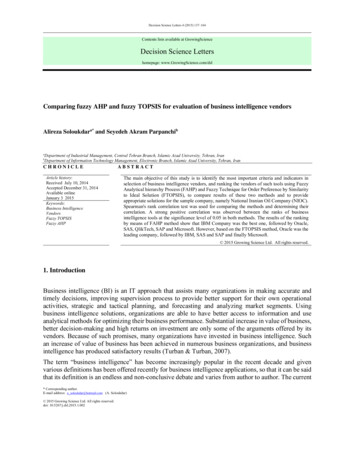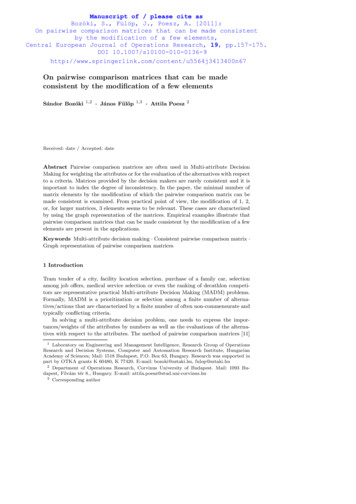
Transcription
Manuscript of / please cite asBozóki, S., Fülöp, J., Poesz, A. [2011]:On pairwise comparison matrices that can be made consistentNoname manuscript No.by the modification of a few elements,(will be inserted by the editor)Central European Journal of Operations Research, 19, pp.157-175.DOI om/content/u5564j3413400n67On pairwise comparison matrices that can be madeconsistent by the modification of a few elementsSándor Bozóki1,2· János Fülöp1,3· Attila Poesz2Received: date / Accepted: dateAbstract Pairwise comparison matrices are often used in Multi-attribute DecisionMaking for weighting the attributes or for the evaluation of the alternatives with respectto a criteria. Matrices provided by the decision makers are rarely consistent and it isimportant to index the degree of inconsistency. In the paper, the minimal number ofmatrix elements by the modification of which the pairwise comparison matrix can bemade consistent is examined. From practical point of view, the modification of 1, 2,or, for larger matrices, 3 elements seems to be relevant. These cases are characterizedby using the graph representation of the matrices. Empirical examples illustrate thatpairwise comparison matrices that can be made consistent by the modification of a fewelements are present in the applications.Keywords Multi-attribute decision making · Consistent pairwise comparison matrix ·Graph representation of pairwise comparison matrices1 IntroductionTram tender of a city, facility location selection, purchase of a family car, selectionamong job offers, medical service selection or even the ranking of decathlon competitors are representative practical Multi-attribute Decision Making (MADM) problems.Formally, MADM is a prioritization or selection among a finite number of alternatives/actions that are characterized by a finite number of often non-commensurate andtypically conflicting criteria.In solving a multi-attribute decision problem, one needs to express the importances/weights of the attributes by numbers as well as the evaluations of the alternatives with respect to the attributes. The method of pairwise comparison matrices [11]1 Laboratory on Engineering and Management Intelligence, Research Group of OperationsResearch and Decision Systems, Computer and Automation Research Institute, HungarianAcademy of Sciences; Mail: 1518 Budapest, P.O. Box 63, Hungary. Research was supported inpart by OTKA grants K 60480, K 77420. E-mail: bozoki@sztaki.hu, fulop@sztaki.hu2 Department of Operations Research, Corvinus University of Budapest. Mail: 1093 Budapest, Fővám tér 8., Hungary. E-mail: attila.poesz@stud.uni-corvinus.hu3 Corresponding author
2is one of the most often used techniques. Consider n items (weights of criteria, evaluations of the alternatives with respect to a criterion, or voting powers of individualsin group decision making) to be compared. The decision maker compares each pairs ofthe items and answers the question like ’How many times one is larger/better than theother one?’. An n n matrix 1 a12 a13 . . . a1n a 21 1 a23 . . . a2n a a 1.a31 323n A . . . . . . .an1 an2 an3 . . .1is called pairwise comparison matrix if it is positive and reciprocal, i.e.,aij 0,1,aij ajifor i, j 1, . . . , n.A pairwise comparison matrix A is consistent if it satisfies the transitivity propertyaij ajk aikfor any indices i, j, k, (i, j, k 1, 2, . . . , n). Otherwise, A is inconsistent.There is a number of methods for determining the weights from the pairwise comparison matrix filled in by the decision maker. Eigenvector method [11] and distanceminimizing methods such as Least Squares Method [4, 1, 3] are just two of the basicideas of the approximation of an inconsistent matrix by a consistent one. All weightingmethods provide the same result for consistent matrices but not for inconsistent ones.However, in the paper, the focus is rather on the matrices that can be made consistentby modifying 1, 2 or 3 of their elements than on weighting methods.In real decision problems consistent matrices are rare but it is crucial to detect highinconsistencies. Contradictive responses of the decision maker may result in false outcomes. Nevertheless, the definition of the degree of inconsistency is not unique, thereexist different measures and indices for it [11, 8, 2]. An alternative way is presentedin the paper for finding the minimal number of elements in the pairwise comparisonmatrix by the modification of which it can be made consistent. Graph representationof pairwise comparison matrices [5, 7] is used in the paper as an efficient tool for agraphical interpretation of decision maker’s preferences.The paper is organized as follows. Graph representation of pairwise comparisonmatrices and its relations to consistency are presented in Section 2. In Section 3, amixed 0-1 program is defined for determining the minimal number of the elementswhose modification can make a pairwise comparison matrix consistent. In Sections 4,5 and 6 the cases of 1 element, 2 elements and 3 elements to modify, respectively, arediscussed. Tests on empirical pairwise comparison matrices originated from real decisions are summarized in Section 7.
3 Fig. 1 The subgraph for the proof of Proposition 12 Inconsistent triadsLet A be an n n pairwise comparison matrix, and letĀ log Adenote the n n matrix withāij log aij , i, j 1, . . . , n.Then A is consistent if and only ifāij ājk āki 0, i, j, k 1, . . . , n.Introduce the directed graph G {N , A} where N {1, . . . , n} is the set of the nodesand A {(i, j) i, j N , i 6 j} is the set of the edges. Let weights be associated withthe edges of graph G, namely, weight āij with the edge (i, j).Let i, j and k be three different nodes of G. The cycle consisting of the threeconnecting edges (i, j), (j, k), (k, i) is called a triad, denoted by (i, j, k). The weightw(i, j, k) of triad (i, j, k) is defined byw(i, j, k) āij ājk āki .It is clear thatw(i, j, k) w(j, k, i) w(k, i, j) w(k, j, i) w(j, i, k) w(i, k, j),furthermore, matrix A is consistent exactly when the weight of all triads is zero in thegraph G associated with A. A triad is called consistent if its weight is zero, otherwise,it is called inconsistent. We call the graph G also consistent when all of its triads areconsistent. In the sequel, when dealing with the number of the inconsistent triads, weconsider the triads (i, j, k), (j, k, i), (k, i, j), (k, j, i), (j, i, k), (i, k, j) as identical, andcount them only once, since they are based on the same triple of nodes, and they areconsistent or inconsistent simultaneously.It is evident that for a consistent matrix A, the graph G does not contain anyinconsistent triad. However, as shown below, for an inconsistent A, the graph G containsat least n 2 inconsistent triads.Proposition 1. Let (i, j, k) be an inconsistent triad. Then for any l N \ {i, j, k}, atleast one of the triads (l, i, j), (l, j, k) and (l, k, i) is inconsistent.
4Proof: It is easy to see, as shown in Figure 1, thatw(l, i, j) w(l, j, k) w(l, k, i) w(i, j, k).Note that Figure 1 shows the subgraph of G consisting only of the nodes and edgesneeded in the proof. Since w(i, j, k) 6 0, at least one of the other three triads musthave a nonzero weight. Since the node l N \ {i, j, k} can be chosen in n 3 ways, and (i, j, k) is inconsistent, we obtain directly:Corollary 1. If A is inconsistent, then G contains at least n 2 inconsistent triads. Corollary 2. If A is inconsistent, then for any i N , G contains an inconsistent triad(i, j, k). A direct practical application of Corollary 2 is the following: when we want to checkwhether the pairwisecomparison matrix A is consistent or not, instead of checking the consistency of n3 triads, it is enough to do that for n 1triads.2Corollary 2 has the further meaning that the inconsistency of a triad spreads over,namely, any alternative (or criterion) taking role in the pairwise comparison cannotelude the effect of the inconsistency among any three alternatives (or criterion). This iswhy it is so difficult to find a cause of the inconsistency in a pairwise comparison matrix.3 The minimal number of elements to be modifiedIt can happen in the practice that the person who performs the pairwise comparisonsworks basically in a precise and consistent way, and makes errors only in a few cases.If the classic eigenvector or optimization techniques mentioned and referred in the Introduction are applied in this case, then in the consistent pairwise comparison matrixobtained as an approximation by these techniques, the earlier correct pairwise comparison values may be destroyed. Furthermore, the alternatives may get merit weightsnot reflecting the real situation at all.An inconsistent pairwise comparison matrix can be made consistent by modifying Kof its elements (and their reciprocals) if and only if it can be obtained from a consistentmatrix by modifying K of the elements (and their reciprocals) in the latter matrix.In the following, when we speak about the modification of an element in a pairwisecomparison matrix, the appropriate modification of the reciprocal is also reckoned in,even if it is not mentioned explicitly. The modification concerns, of course, only theoff-diagonal elements since every element is 1 in the diagonal of a pairwise comparisonmatrix.In the following we present some tools to elicit whether an inconsistent pairwisecomparison matrix can be made consistent by modifying a few (1, 2 or 3) of its elements. If the answer is affirmative, it may be worthwhile calling the attention of theperson performing the pairwise comparisons to this fact. It may happen that he madeindeed mistakes, and he is disposed to reconsider those values. However, of course, hemay insist on those values, and other, classic tools can be applied for handling theinconsistent pairwise comparison matrix in the further steps.Two approaches will be proposed. The first one constructs a mixed 0-1 programming problem to answer the question how can an inconsistent pairwise comparison
5matrix be made consistent by modifying the minimal number of its elements. Thesecond approach is based on elementary, graph theoretic analysis of the graph G.Assume that an M 1 is given serving as an upper bound on the values of theelements in the original and the modified pairwise comparison matrices, i.e. we haveaij M, i, j 1, . . . , n(1)for the elements of A, and we want the modified matrix also with this property. Inthe practice, this is not a serious restriction since an interval of the reasonable valuesis usually known. In the Analytic Hierarchy Process M is set to 9, however, it isdefined only for the elements given by the decision maker. The role of M related toinconsistency indices is discussed in [2]. Let M̄ log M , this is an upper bound on theabsolute value of the logarithms of the original and the modified elements. Considerthe following optimization problem:minn 1XnXyiji 1 j i 1s.t.1 i j k n,xij xjk xki 0,xij xji ,1 i j n, M̄ xij M̄ ,(2)1 i j n, 2M̄ yij xij āij 2M̄ yij ,1 i j n,yij {0, 1},1 i j n,where xij , i, j 1, . . . , n, i 6 j, are continuous variables and denote the logarithms ofthe elements in the modified matrix, yij , i 1, . . . , n 1, j i 1, . . . , n, are binaryvariables meaning that the modification is allowed in the position (i, j) (then yij 1)or not (then yij 0). The following statement is evident:Proposition 2. The optimal value of problem (2) gives the minimal number of theelements that can be modified to make the pairwise comparison matrix A consistentassuming (1) for A and requiring (1) for the modified matrix. If we only want to know whether the matrix A can be made consistent by modifyingat most K of its elements, then the constraintn 1PnPyij K(3)i 1 j i 1is to be added to (2), and it is enough to search only for a feasible solution of (2)-(3).The practical computational application of the above approach necessitates thatan optimization software capable to solve problems (2) or (2)-(3) be callable from thedecision support system. An integer programming method of general purpose can solveproblems (2) and (2)-(3) with n2 binary variables in an exponential number of steps.An advantage of the graph theoretic approach to be proposed below is that it doesnot necessitates the application of an optimization tool, and it is easy to implement.Constraint (1) that served basically to establish the mixed-binary program (2) can alsobe omitted. Furthermore, for a given K, polynomial algorithms can be applied contraryto exponential algorithms needed to solve problems (2) and (2)-(3).
6 Fig. 2 The subgraph for the proof of Proposition 3 in case of n 44 The case of single modificationA special case of problem (2) is when an appropriate change of a single element leadsto a consistent matrix.Proposition 3. An inconsistent pairwise comparison matrix A can be made consistentby modifying a single element if and only if the corresponding graph G contains exactlyn 2 inconsistent triads. If n 4, then the modification, if any, is unique.Proof: To prove the necessity, assume that A can be obtained by modifying a singleelement of a consistent matrix. If we modify a single element of consistent matrix, thenthe weight of the corresponding edge (and of the opposite edge) is also modified. Thisedge is exactly in n 2 triads of the graph, neglecting the direction of the edges. Themodification of the weight of the considered edge implies the modification of the weightof n 2 triads from zero to nonzero, the weight of any other triad does not changehowever. Consequently, the graph G obtained by modifying a single element containsn 2 inconsistent triads.To prove the sufficiency, assume that graph G contains n 2 inconsistent triads.In case of n 3, it is trivial that A can be made consistent by a suitable modificationof any of its off-diagonal elements. The case of n 4 is also easy to handle. ThenN {1, 2, 3, 4}, there are four triads in the graph, two of them are inconsistent, andtwo of them are consistent. We can assume, without loss of generality, that the triads(1, 2, 3) and (1, 3, 4) are inconsistent, and the triads (2, 4, 1) and (2, 3, 4) are consistent(Figure 2). Thenā2,4 ā4,1 ā1,2 0, ā2,3 ā3,4 ā4,2 0.By adding up the two equalities and using āij āji , i, j 1, . . . , 4, we getā1,2 ā2,3 ā1,4 ā4,3 .Let β denote the value of the both sides in the previous equality. Modify the weight ofthe edge (1, 3) as follows:ā1,3 β, ā3,1 β.Now the triads (1, 2, 3) and (1, 3, 4) are already consistent, but the modification doesnot concern the earlier consistency of the triads (2, 4, 1) and (2, 3, 4).We turn now to the case of n 5. Consider an inconsistent triad (i, j, k), and letα w(i, j, k). Since the graph G contains n 2 inconsistent triads, it follows fromProposition 1 that for any l N \ {i, j, k} exactly one of the triads (l, i, j), (l, j, k)
7Fig. 3 The subgraph for the proof of Proposition 3 in case of n 5 Fig. 4 The subgraph to show that the same edge of (i, j, k) appears in the inconsistent triadsand (l, k, i) is inconsistent. We show that the weight of this inconsistent triad is alsoα. Assume that for an l N \ {i, j, k} the triad (l, i, j) is inconsistent (Figure 3). Thenthe triads (l, j, k) and (l, k, i) are consistent, and adding up the equalitiesālj ājk ākl 0, ālk āki āil 0and rearranging them, we getājk āki ājl āli ,thusāij ājk āki āli āij ājl α.We show now that for any l N \ {i, j, k}, always the same edge of the triad(i, j, k) appears in the inconsistent triad obtained by including the node l. Assumecontrarily that for an l1 N \ {i, j, k} the triad (l1 , i, j) is inconsistent, and for anotherl2 N \{i, j, k} the triad (l2 , k, i) is inconsistent (Figure 4). Then (l2 , j, k) is consistent,and the triad (j, l2 , l1 ) is also consistent since any inconsistent triad must have an edgefrom those of (i, j, k). Summing up the weights of (l2 , j, k) and (j, l2 , l1 ) we getājk ākl2 āl2 l1 āl1 j 0.(4)The triad (i, l2 , l1 ) is consistent, i.e. w(i, l2 , l1 ) 0, furthermore, w(i, j, k) α andw(l1 , j, i) w(l2 , i, k) α. As shown in Figure 4, summing up the weights of triads(i, l2 , l1 ), (l1 , j, i), (i, j, k) and (l2 , i, k) we getājk ākl2 āl2 l1 āl1 j α,
8that, because of α 6 0, contradicts (4).For the sake of simplicity assume that for any l N \ {i, j, k} the triad (l, i, j) isinconsistent. The weight of the triads (l, i, j) is just w(i, j, k) α. Modify the valueof āij to āij α. By this modification, the weights of the triads based on the edge(i, j) become zero, but the weights of the originally consistent triads do not change.Consequently, by the appropriate modification of the weight of edge (i, j), as well asby modifying the elements aij (and aji ), matrix A has been made consistent.In the case of n 4 the uniqueness of the modification comes from the fact thatonly that edge (i, j) found above appears in all the n 2 inconsistent triads. Thenecessary modification of the edge (i, j) is also unique. If the weight of any other edgewas modified, that would leave the weight of at least one of the n 2 inconsistent triadsunchanged. Remark 1. It is easy to see that checking whether the number of the inconsistenttriads is n 2 or not can be performed with O(n3 ) operations. If the condition holds,the edge to be modified and how to modify can be obtained immediately from thecommon edge and the same weight of any pair of inconsistent triads.Proposition 4. Let A be a pairwise comparison matrix obtained from a consistentpairwise comparison matrix by modifying K elements (and their reciprocals). Then thegraph G associated with A contains at most K(n 2) inconsistent triads.Proof: If we start from a graph associated with a consistent matrix, and in each of Ksteps we modify the weight of an edge, then the weight of n 2 triads is modified inevery step. The weight of a triad can change even in more than one step, but altogether,the weight of at most K(n 2) triads can change. Since every triad was consistent atstarting, G can contain at most K(n 2) inconsistent triads. Contrary to the case of K 1, when exactly n 2 inconsistent triads are in theobtained graph, in the case of K 1 the number of the inconsistent triads depends onthe connection of the modified edges and the relations among the modifications, too.It is easy to see that when the modified edges are independent, i.e. the edges have nocommon nodes, then the number of inconsistent triads is just K(n 2). However, ifsome of the edges are connected, then the effects of the modifications can extinguisheach other so the weight of a modified triad may finally become zero. It is shown in[9] that in case of K 2 the number of the inconsistent triads can vary betweenK(n 2) 2 and K(n 2), and in case of K 3 between K(n 2) 6 and K(n 2).The reader can easily verify these findings by enumerating the possible dispositions ofthe modified edges. It can even happen that after modifying K elements, the matrixremains consistent as shown in the example below.Example 1. Let n 3, and consider the n n pairwise comparison matrix defined by α, i 1; j 2, . . . , n,aij 1/α, j 1; i 2, . . . , n, 1,otherwise,where α 0 is arbitrary. It is easy to see that this matrix is consistent. Modifying then 1 elements with value α to another value of α, and modifying the reciprocals, too,another consistent pairwise comparison matrix is obtained.In the light of Propositions 3 and 4, it may arise the conjecture that an inconsistentpairwise comparison matrix A can be made consistent by modifying at most K elements
94log 73001log 5 0log 32Fig. 5 The subgraph of Example 2if and only if the associated graph G contains at most K(n 2) inconsistent triads.This conjecture is however not true as shown in the next example.Example 2. Let n 4 and1 1A 11 111/31/51311/7 15 .7 1All the four triads of the graph G associated with A are inconsistent, in addition, theirweights are different (Figure 5). By Proposition 3, it is clear that A cannot be madeconsistent by modifying a single element. Since for K 2 we have K(n 2) 4, ifthe conjecture was true, then A would be made consistent by modifying two elements.However, after having modified the weight of any of the edges of G, at least threeinconsistent triads remain, and they cannot be corrected by modifying the weight of afurther edge.As the example above shows, merely the number of the inconsistent triads does notyield a sufficient condition. The connection of the inconsistent triads, their weights andthe relations among them are also to be taken into account. Proposition 3 is rephrasedin terms of this remark, and its proof comes directly from that of Proposition 3.Proposition 5. An inconsistent pairwise comparison matrix A can be made consistentby modifying a single element if and only if there exists an edge (i, j) in the associatedgraph G such that the weight of all triads (l, i, j), l N \ {i, j} is the same nonzerovalue, and all the other triads are consistent. For the edge (i, j) with this property,the modification is unique. If n 4, then there exits at most one edge (i, j) with thisproperty. 5 Modification of two elementsThe phrasing of the proposition concerning the modification of the weight of two edgesis similar to that of Proposition 5, it is however more involved since the connectionof the two edges is also to be taken into account. Namely, the two edges are eitherindependent (Figure 6(a)) or are connected in a common node (Figure 6(b)). It is easyto see that in case of n 3 only the layout of Figure 6(b) can occur, furthermore, anyinconsistent matrix A can be made consistent by modifying two elements in an infinitenumber of ways.
10 Fig. 6 The possible dispositions of two edgesProposition 6. An inconsistent pairwise comparison matrix A can be made consistentby modifying two elements if and only if exactly one of the following two conditionsholds in the graph G associated with A:1. There are two independent edges (i1 , j1 ) and (i2 , j2 ), and nonzero values α1 andα2 such that w(l, i1 , j1 ) α1 for all l N \ {i1 , j1 }, w(l, i2 , j2 ) α2 for alll N \ {i2 , j2 }, and all other triads are consistent.2. There are two connected edges (i, j) and (j, k), and nonzero values α1 and α2 suchthat w(l, i, j) α1 and w(l, j, k) α2 for all l N \ {i, j, k}, w(i, j, k) α1 α2 ,and all other triads are consistent.If n 4, then for any pair of edges fulfilling conditions 1 or 2, the modification of theweights of the edges that makes the graph G consistent is unique. If n 5, then thereexists at most one pair of edges fulfilling condition 1. If n 6, then there exists atmost one pair of edges fulfilling condition 2.Proof: First, assume that A can be made consistent by modifying two elements. Thetwo corresponding edges in graph G are either the independent (i1 , j1 ) and (i2 , j2 ), orthe connected (i, j) and (j, k). Assume that in order to make A consistent we add anonzero β1 to āi1 j1 and a nonzero β2 to āi2 j2 in the first case, and a nonzero β1 to āijand a nonzero β2 to ājk in the second case. Consequently, in the first case, the weightof triad (l, i1 , j1 ) is modified by adding β1 to it for all l N \ {i1 , j1 }, and the weightof triad (l, i2 , j2 ) is modified by adding β2 to it for all l N \ {i2 , j2 }. Similarly, in thesecond case, the weights of triads (l, i, j) and (l, j, k) are modified by adding β1 and β2 ,respectively, to them for all l N \ {i, j, k}, and the weight of triad (i, j, k) is modifiedby adding β1 β2 to it. Since the weight of any triad is zero in the modified graph, itis evident that with α1 β1 and α2 β2 , condition 1 holds in the first case, andcondition 2 holds in the second case.The sufficiency is trivial. If condition 1 holds, we add α1 to āi1 j1 and α2 toāi2 j2 . Similarly, if condition 2 holds, we add α1 to āij and α2 to ājk , and all triadsbecome consistent.We show now that at most one of conditions 1 and 2 can hold. Assume contrarilythat both conditions hold. This means that G can be obtained from a consistent graphby modifying the weights of independent edges (i1 , j1 ) and (i2 , j2 ), and can be madeconsistent by modifying the weights of two connected edges (i, j) and (j, k). However,the four triads based on i1 , j1 , i2 and j2 are inconsistent, and it is easy to see that allof them cannot be made consistent by modifying the weights of two connected edges.It follows also easily from the proof above that if n 4 and a pair of edges fulfillsconditions 1 or 2, then the modification of the weights of the two edges to make Gconsistent is unique.
11Let n 5, and consider a pair of edges fulfilling condition 1. Assume that thereis another pair of edges with this property. We can assume without loss of generalitythat the first pair is the one constructed in the proof of sufficiency, i.e. the one inFigure 6(a), furthermore, the edge (i1 , j1 ) is in the first pair but is not in the secondone. Since n 5, there is a node l N different from the endpoints of the edges (i1 , j1 )and (i2 , j2 ). The three triads (l, i1 , j1 ), (i2 , i1 , j1 ) and (j2 , i1 , j1 ) are inconsistent. It isevident that these three triads cannot be made consistent by modifying the weights ofthe second pair of edges since (i1 , j1 ) is not in the second pair.Let n 6, and now consider a pair of edges fulfilling condition 2. Again, assumethat there is another pair of edges with this property. We can assume without loss ofgenerality that the first pair is the one constructed in the proof of sufficiency, i.e. theone in Figure 6(b), furthermore, the edge (i, j) is in the first pair but is not in thesecond one. Since n 6, there exist three different nodes l1 , l2 and l3 also differentfrom i, j and k. The triads (l1 , i, j), (l2 , i, j) and (l3 , i, j) are inconsistent, and theycannot be made consistent by modifying the weights of the second pair of edges since(i, j) is not in the second pair. Remark 2. If n 4, then the number of the pairs of edges fulfilling conditions 1 or 2may not be unique. This means that an inconsistent pairwise comparison matrix A canbe altered into different consistent forms by modifying two elements (and their reciprocals). For example, condition 1 holds for the graph G associated with the inconsistentpairwise comparison matrix 1 a1 1 1/a 1 1 1 (5) 1 1 1 1/a ,1 1a 1where a 6 1, and (5) can be altered into the different consistent form 1 aa 11111 1/a 1 1 1/a 1 1 1 1 and 1/a 1 1 1/a 1 1 1 1 1 aa 11111by modifying two elements (and their reciprocals). Similarly, condition 2 holds for thegraph G associated with the inconsistent pairwise comparison matrix 1 a1b 1/a 1 1 1 (6) 1 1 1 1 ,1/b 1 1 1where a 6 1, b 6 1, a 6 b, and (6) can be altered into the 11111 aaa 1/a 1 1 1 1 1 1 1 and 1/a 1 1 1 1 1 1 1 ,1/a 1 1 11111different consistent forms 1 b b b 1/b 1 1 1 1/b 1 1 1 1/b 1 1 1by modifying two elements (and their reciprocals).There are four inconsistent triads in (5) and three in (6), thus, according to Proposition 3, neither (5) or (6) can be made consistent by modifying a single element and
12its reciprocal. For n 4, it can be shown that the maximal number of the differentpairs of edges fulfilling condition 1 is two, and this number is three for condition 2.The proof, based on enumeration of the possible cases and simple arithmetics, is leftto the reader.Remark 3. If n 5, then the number of the pairs of edges fulfilling condition 2 maynot be unique. For example, condition 2 holds for the graph G associated with theinconsistent pairwise comparison matrix1 1/a 1/a 11 a1111a111111111 11 1 ,1 (7)1where a 6 1, and (7) can be altered into the different consistent forms1 1 1 11 111111111111111 11 1 1 11 1/a 1/a 1/a1/a anda1111a1111a1111 a1 1 1 1by modifying two elements (and their reciprocals). Since there are four inconsistenttriads in (7), it cannot be made consistent by modifying a single element and itsreciprocal. For n 5, it can be shown that the maximal number of the different pairsof edges fulfilling condition 2 is two. The proof is left again to the reader.Remark 4. To perform the operations according to Proposition 6, we have first to prepare the list of the inconsistent triads. This can be done with O(n3 ) operations. If thenumber of the inconsistent triads is less than 2(n 2) 2 or greater than 2(n 2), thenit is sure that there is not any pair of edges fulfilling conditions 1 or 2 of Proposition6. Otherwise, from the list of the edges appearing in the list of the inconsistent triads,we can prepare a list of O(n2 ) pairs of edges as candidates to fulfill conditions 1 or 2.For each of these pairs, we can check condition 1 if the two edges are independent, orcondition 2 if they are connected with O(n) operations. To check that only triads basedon at least one of the two edges can be found in the list of the inconsistent triads, O(n)further operations are needed. Altogether, the pairs of edges fulfilling conditions 1 or2, if any, and how to modify can be determined with O(n3 ) operations. Remember,however, that even if the number of the inconsistent triads is 2(n 2) 2, 2(n 2) 1or 2(n 2), it may happen that there is not any pair of edges fulfilling conditions 1 or2 of Proposition 6, as shown in Example 2.6 Modification of three elementsThe case of K 3, i.e. the investigation whether an inconsistent matrix A can be madeconsistent by modifying three of its elements (and their reciprocals) i
off-diagonal elements since every element is 1 in the diagonal of a pairwise comparison matrix. In the following we present some tools to elicit whether an inconsistent pairwise comparison matrix can be made consistent by modifying a few (1, 2 or 3) of its ele-ments. If the answer is affirmative, it may be worthwhile calling the attention of the

